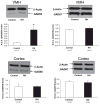Increased GABAergic tone in the ventromedial hypothalamus contributes to suppression of counterregulatory responses after antecedent hypoglycemia
- PMID: 18375441
- PMCID: PMC5518793
- DOI: 10.2337/db07-1559
Increased GABAergic tone in the ventromedial hypothalamus contributes to suppression of counterregulatory responses after antecedent hypoglycemia
Abstract
Objective: We have previously demonstrated that modulation of gamma-aminobutyric acid (GABA) inhibitory tone in the ventromedial hypothalamus (VMH), an important glucose-sensing region in the brain, modulates the magnitude of glucagon and sympathoadrenal responses to hypoglycemia. In the current study, we examined whether increased VMH GABAergic tone may contribute to suppression of counterregulatory responses after recurrent hypoglycemia.
Research design and methods: To test this hypothesis, we quantified expression of the GABA synthetic enzyme, glutamic acid decarboxylase (GAD), in the VMH of control and recurrently hypoglycemic rats. Subsequently, we used microdialysis and microinjection techniques to assess changes in VMH GABA levels and the effects of GABA(A) receptor blockade on counterregulatory responses to a standardized hypoglycemic stimulus.
Results: Quantitative RT-PCR and immunoblots in recurrently hypoglycemic animals revealed that GAD(65) mRNA and protein were increased 33 and 580%, respectively. Basal VMH GABA concentrations were more than threefold higher in recurrently hypoglycemic animals. Furthermore, whereas VMH GABA levels decreased in both control and recurrently hypoglycemic animals with the onset of hypoglycemia, the fall was not significant in recurrently hypoglycemic rats. During hypoglycemia, recurrently hypoglycemic rats exhibited a 49-63% reduction in glucagon and epinephrine release. These changes were reversed by delivery of a GABA(A) receptor antagonist to the VMH.
Conclusions: Our data suggest that recurrent hypoglycemia increases GABAergic inhibitory tone in the VMH and that this, in turn, suppresses glucagon and sympathoadrenal responses to subsequent bouts of acute hypoglycemia. Thus, hypoglycemia-associated autonomic failure may be due in part to a relative excess of the inhibitory neurotransmitter, GABA, within the VMH.
Figures







References
-
- The Diabetes Control and Complications Trial Research Group. The effect of intensive treatment of diabetes on the development and progression of long-term complications in insulin-dependent diabetes mellitus. N Engl J Med. 1993;329:977–986. - PubMed
-
- UK Prospective Diabetes Study (UKPDS) Group. Intensive blood-glucose control with sulphonylureas or insulin compared with conventional treatment and risk of complications in patients with type 2 diabetes (UKPDS 33) Lancet. 1998;352:837–853. - PubMed
-
- Cryer PE. Hypoglycaemia: the limiting factor in the glycaemic management of type I and type II diabetes. Diabetologia. 2002;45:937–948. - PubMed
-
- Segel SA, Paramore DS, Cryer PE. Hypoglycemia-associated autonomic failure in advanced type 2 diabetes. Diabetes. 2002;51:724–733. - PubMed
Publication types
MeSH terms
Substances
Grants and funding
LinkOut - more resources
Full Text Sources
Medical

